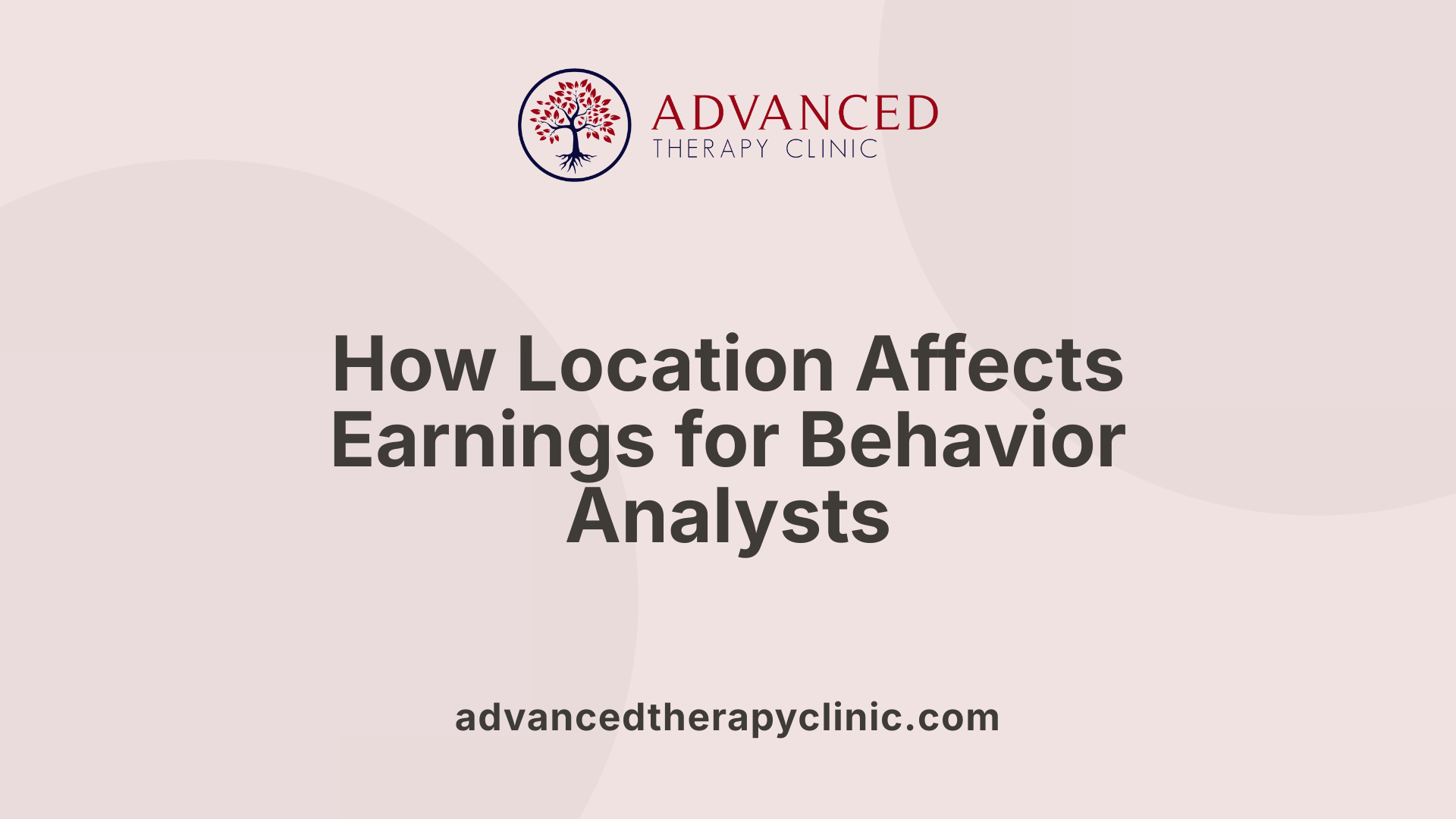Average BCaBA Salary By State


Understanding the Variations in BCaBA Salaries Across the U.S.
The salary landscape for Behavior Analysts, particularly BCaBAs, varies significantly from state to state, influenced by regional demand, cost of living, and industry growth. As the field of applied behavior analysis continues to expand, especially amidst rising recognition of its effectiveness, understanding these salary patterns is vital for professionals making career decisions or negotiating compensation. This article explores the current salary averages, regional influences, factors shaping earning potentials, comparative rankings, and emerging trends that define the economic outlook for BCaBAs across the nation.
Average Salaries for BCaBAs and BCBAs Across States

What are the average salaries for BCaBA and BCBA professionals across different states?
Salaries for behavior analysts, including BCaBAs and BCBAs, differ widely across the United States. The national average for BCBA®s is approximately $75,784 annually, with top-paying states like New Jersey reaching up to $83,183. For BCaBAs, the average in the country is around $70,884, but this varies greatly depending on location. Massachusetts leads with an average salary of about $95,048, followed by Hawaii at $94,601, and Maryland at $71,150. Conversely, states like Arkansas and South Carolina report lower averages, around $47,153 and $39,667, respectively.
How does location affect salaries?
Urban areas tend to have higher wages for behavior analysts due to increased demand and higher living costs. Cities such as San Francisco, CA, reach average salaries of nearly $94,846 for BCBAs, while cities like Santa Cruz and Redwood City, CA, pay over $112,000 and $111,000 respectively. These figures highlight the strong influence of geographic location on earning potential.
Does certification level and industry impact earnings?
Higher certification levels, experience, and industry sectors significantly influence salary expectations. For example, BCBAs generally earn 30% to 50% more than BCaBAs. Industry also plays a role—roles in government tend to pay around $75,181, whereas healthcare and professional services can offer slightly lower wages. Furthermore, advanced degrees and years of experience can substantially boost annual earnings.
| State | Average BCBA Salary | Top Cities/Regions | Notes |
|---|---|---|---|
| New Jersey | $83,183 | Newark, Trenton | Highest average nationally |
| California | ~$89,075 | San Francisco, Santa Cruz | Urban centers pay premium |
| Hawaii | $94,601 | Honolulu | Top BCaBA salaries among states |
| Arkansas | $47,153 | Little Rock | Lower end of salary spectrum |
| South Carolina | $39,667 | Charleston, Columbia | Significant variation across states |
Overall, the prospect for behavior analysts continues to improve. As demand for ABA services grows in various settings, salaries are expected to increase, especially in high-demand regions like California, Florida, and Texas.
Regional and Geographic Influences on Salary

How do regional and geographic factors influence salaries for behavior analysis professionals?
Salaries for behavior analysis professionals, including BCBAs and BCaBAs, vary widely depending on where they work. Regions with a higher cost of living, such as the Northeast and parts of California, generally offer higher wages to offset expenses and attract qualified personnel. For example, New Jersey boasts an average BCBA salary of around $98,707 annually, while Massachusetts residents earn approximately $95,048. In contrast, states with a lower cost of living, such as Alabama and Florida, tend to have lower average salaries around $55,000 to $60,000.
Demand for behavioral services strongly influences salary levels. High-demand states like California, Texas, and Massachusetts report increasing need for BCBAs and BCaBAs, which pushes wages upward in these regions. Urban centers, especially large metropolitan areas, tend to provide greater earning opportunities. Cities like San Francisco, CA, where the average salary hits approximately $93,846, and Santa Cruz, CA, at $112,456, exemplify how urban settings often pay more due to higher demand and availability of resources.
On the other hand, rural and less populated areas typically offer lower salaries, reflecting fewer job opportunities and less regional demand. This urban versus rural disparity underscores the geographic impact on earning potential for behavior analysts.
Overall, the geography and economic landscape of each region shape the salaries for behavior analysts in the U.S. Cost of living, demand for services, and regional economic health all play crucial roles in determining wages across different states and cities.
Factors Influencing Salary Levels Across States

What factors affect the salary levels of BCaBA and BCBA roles across different states?
Salaries for behavioral analysts, including BCaBAs and BCBAs, vary widely across the United States, influenced by several important factors. Geographic location is a primary determinant; professionals working in large urban centers and high-cost states such as California, New Jersey, and New York generally command higher wages. For example, the average salary in San Francisco reaches nearly $94,000 annually, while in states like Alabama or Florida, salaries tend to be lower, closer to $53,000.
Education and certification significantly impact pay as well. Holding advanced degrees or certifications such as BCBA-D can lead to earning above $120,000 per year, especially in regions with high demand. Experience is another critical factor; seasoned professionals with several years in the field can earn substantially more than newcomers, with experienced BCBA salaries reaching over $100,000 in some areas like Georgia.
The industry sector and employer type also influence compensation. Private practices and corporate organizations typically offer higher salaries compared to government or non-profit agencies. Demand for services and regional legislation, such as laws requiring autism treatment coverage, enhance job opportunities and potential earnings.
Additionally, professionals' negotiation skills, scope of practice, and opportunities for leadership roles may also improve salary prospects. As the demand for behavior analysis continues to grow, especially in regions with expanding educational and healthcare infrastructure, salaries are expected to keep increasing, making location and professional credentials key to maximizing earnings.
Salary Rankings and Comparisons Among States

Are there rankings or comparisons of salaries for behavior analysts across states?
Yes, numerous industry surveys and salary reports evaluate and compare the earnings of behavior analysts across various states and cities. These reports utilize data from reputable sources such as ZipRecruiter, Salary.com, and the Behavior Analyst Certification Board® (BACB®), providing a comprehensive view of how salaries differ geographically.
Top-paying states include Alaska, with an average BCBA salary of about $99,394 annually, and New Jersey, where BCBAs earn approximately $98,707 per year. Massachusetts also ranks high, with salaries near $83,000. These states often have the highest median wages, thanks to strong demand and higher costs of living.
City-specific data reveals that metropolitan areas like San Francisco, CA, lead the list of highest salaries, with average earnings around $93,846 annually. Cities like Santa Cruz and Redwood City further underscore the trend where urban centers with high demand and competitive markets offer remuneration exceeding $110,000.
State-by-state comparisons highlight significant variations influenced by local demand, economic factors, and legislation supporting autism services. For instance, Georgia's average salary for experienced BCBAs can reach up to $106,770, while other states like Alabama and Florida tend to offer lower wages, closer to $53,000.
These rankings are valuable for professionals considering relocations or negotiating salaries. They reflect regional differences shaped by the demand for behavior analysis services, industry growth, and living costs, helping professionals make informed decisions about their careers.
Latest Trends and Future Outlook for BCaBA and BCBA Salaries
What are the recent trends in salary data for BCaBA and BCBA professionals?
Recent trends in salary data for BCaBA and BCBA professionals show steady growth, driven by increasing demand and expanding job opportunities nationwide. The average salary for BCBAs in the U.S. is approximately $85,571 per year as of 2023, with top-paying states like New Jersey and Wisconsin offering salaries exceeding $95,000.
Salaries tend to vary greatly depending on geographic location, experience level, and specialization within the field. Professionals in high-demand regions, such as California and Massachusetts, often earn significantly higher than the national average.
Another emerging trend is the rising impact of telehealth and remote work opportunities. Telehealth positions are often paying 15-25% higher than traditional roles, reflecting the increased accessibility and flexibility of remote services.
Moreover, international consulting work can command hourly rates between $150 and $300, providing additional earning channels beyond standard employment.
Looking ahead until 2030, the salary outlook remains positive. The increasing recognition of applied behavior analysis and its proven benefits ensure continued growth, with some professionals earning up to $151,000 annually. Many BCBAs are exploring entrepreneurial ventures or advanced specializations, which could further enhance their earning capacity.
Overall, the field of behavior analysis remains profitable, with ongoing salary increases coupled with expanding scope for income beyond typical roles.
Growing Opportunities and Earnings in Behavior Analysis
As demand for behavior analysis services continues to soar, salaries for BCaBAs and BCBAs are projected to increase further, especially in high-demand regions and urban centers. Factors like certification, experience, and industry type will remain key drivers of income, while geographic disparities will persist due to regional economic conditions. Prospective and current professionals should stay informed about salary trends and regional opportunities, as the profession offers substantial earning potential, job security, and an expanding scope of practice. With ongoing growth and rising recognition of ABA’s effectiveness, the future looks promising for behavior analysis practitioners wishing to maximize their earning potential across the United States.
References
- BCBA and ABA Salary by State for 2025 - Research.com
- Average BCBA Salary By State - Autism Center of Excellence
- List of BCBA® Salary by State In 2025 - The Behavior Academy
- Board Certified Behavior Analyst Salary in GA
- ABA Therapist Salary Guide 2025 - PsychologyJobs.com
- Behavior Analyst Salaries in 2022 (By State) - Elemy
- BCBA Salary by State 2025 - World Population Review
- BCBA and ABA Salaries by State - Applied Behavior Analysis Degrees
- BCBA and ABA Salary by State for 2025 - Research.com
Recent articles

Expressive Speech Delay 2-Year-Old
Understanding and Addressing Expressive Speech Delay in Toddlers

How Speech Recognition Works
Unlocking the Power of Speech Recognition in Therapy and Healthcare

Autism and Head Size
Understanding the Complex Relationship Between Autism and Head Size

Occupational Therapy in Autism
Enhancing Independence and Quality of Life Through Occupational Therapy in Autism

Do Autistic People Understand Sarcasm?
Navigating the Nuances: Understanding Sarcasm and Social Communication in Autism

Autism Routines
Crafting Effective Daily Structures for Children with Autism

